“The Mountains are calling, and I must go” – John Muir
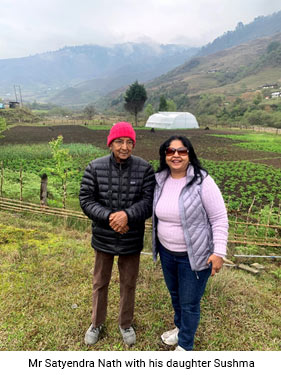 There are a few kindred spirits who echo the same sentiment as John Muir, finding irresistible the urge to escape to the mountains unfailingly year after year. One such travel buff is Mr Satyendra Nath in Jaipur, who unmindful of his 90+ years prepared his travel itinerary for the next journey to the one remaining place on his bucket list, Arunachal Pradesh. This was March 2021, the first wave of Covid19 pandemic barely abated, people yet unvaccinated and fearful. Despite stiff resistance from family, his heart was set and mind made up. The lawyer that he was, he raised many valid arguments. Finally his elder daughter Sushma relented. Her friend joined in. The trio, with a total age of about 212 years between them, embarked on a memorable journey to the remote eastern frontier of India, the hidden gem Arunachal Pradesh.
There are a few kindred spirits who echo the same sentiment as John Muir, finding irresistible the urge to escape to the mountains unfailingly year after year. One such travel buff is Mr Satyendra Nath in Jaipur, who unmindful of his 90+ years prepared his travel itinerary for the next journey to the one remaining place on his bucket list, Arunachal Pradesh. This was March 2021, the first wave of Covid19 pandemic barely abated, people yet unvaccinated and fearful. Despite stiff resistance from family, his heart was set and mind made up. The lawyer that he was, he raised many valid arguments. Finally his elder daughter Sushma relented. Her friend joined in. The trio, with a total age of about 212 years between them, embarked on a memorable journey to the remote eastern frontier of India, the hidden gem Arunachal Pradesh.
Sushma recounted the many merry family road-trips from Bharatpur to Nainital every summer vacation, the journey made on a scooter fitted with a side-car, which she eventually went on to share with her two younger siblings as they came along, the family of five, picnicking at scenic locations en route, making tea. The journeys continued even as the scooter was replaced with four-wheelers specially fitted for overnight halts in the wilderness. She recalls the drive from Bharatpur to Leh, Laddakh via Rohtang Pass, in a soft top Maruti Gypsy with her father, who at 60+ years of age navigated the drive on the treacherous roads himself. Her travelogue inspires even the faint-hearted amongst us to pack our bags and head out to explore new frontiers. At our request she also shared the costs, so that the information may be of help to anyone else planning their journey to these parts.
A Travelogue by Sushma Agrawal
February, 2022
I have inherited my keen interest in travelling from my father, who took me along on so many adventurous trips ever since I was a baby. I love visiting new places, experiencing different cultures, cuisines. Happily, my husband shares the interest and we along with our children have travelled extensively across India and to several countries across the globe.
My nonagenarian father, utterly fed up with remaining confined at home through the entire year of the Covid, in April 2021 announced his plans to travel to the North Eastern State of Arunachal Pradesh all alone. Much as we tried to convince him otherwise, he was adamant. He said, “I am not scared of death. I want to see that place before something happens to me.” My husband advised me to accompany him and simply follow wherever he desired to go.
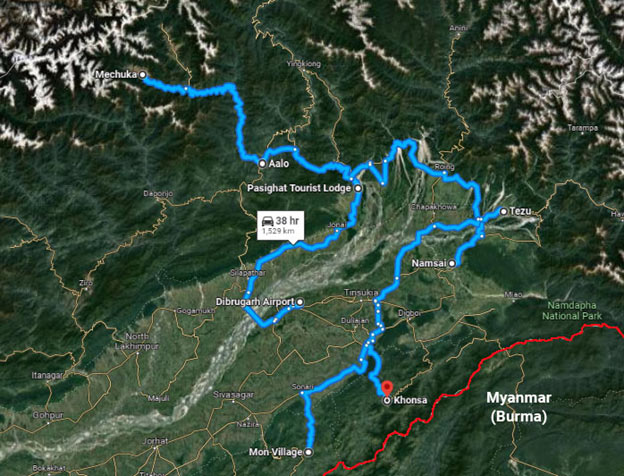
Papa told me the names of places on his itinerary and I was surprised as I have never heard about them. The places he wanted to visit were Passighat, Along, Menchuka, Namsai, Tezu and the two villages Mon and Khonsa near the Myanmar border. I read that the situation in Mon and Khonsa may be sensitive due to the recent coup in Myanmar, and the roads too were very bad so I dropped the idea of going there. Hearing of my plans to go with Papa on this trip one of my good friends also wanted to join us. My father and I were both so excited that it was after fifty nine years that he would be going alone with me, as we did before my siblings arrived. That’s why I consider this trip ‘my most memorable one’.
He came down from Jaipur to join us in Delhi. We booked our air-tickets to Dibrugarh. Another important booking was a reliable taxi for eight days as we wanted a hassle free journey and a good driver who was familiar with all those places. (We paid Rs 5500/- per day including all food and lodging for the driver). We completed all our formalities such as getting the RTPCR tests and getting the Inner Line Permit (ILP) to enter Arunachal Pradesh, for all three of us. (The ILP is essential official travel document issued by the concerned state government to allow inward travel of an Indian citizen into a protected area for a limited period). I read that the Homestays in this region are more popular than hotels, so I also made bookings in good Homestays in each of the towns we planned to stay
The itinerary now was Delhi-Dibrugarh-Passighat-Along-Menchuka-Passighat-Namsai-Dibrugarh-Delhi.
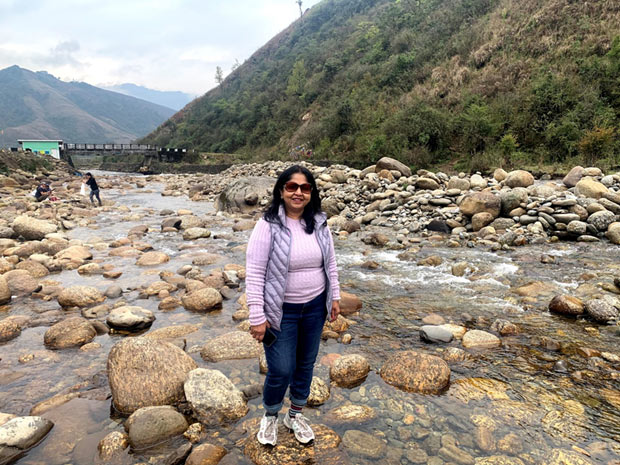
DIBRUGARH, Assam
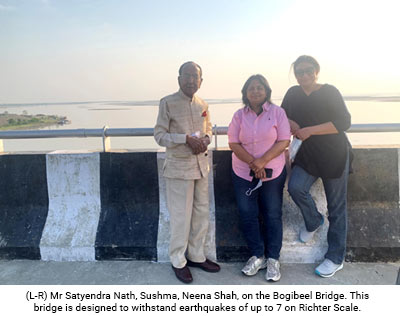 On 5 April, 2021 we reached Dibrugarh airport at 3pm, where we were received by our Taxi Driver, who was a very helpful and a decent person. Before starting out on our journey, we proceeded to buy some mineral water, juice bottles, bread, cheese and butter. It is nearly a 157 km drive from Dibrugarh Airport in Assam to Passighat in Arunachal Pradesh. On the road to Arunachal border, we crossed Bogibeel River Bridge over the wide span of the Brahmaputra River, which is a record 4.94 km long. It is said to be the longest rail-cum-road bridge in India. The countryside was beautiful. We had tea and snacks in a small restaurant and started for Passighat
On 5 April, 2021 we reached Dibrugarh airport at 3pm, where we were received by our Taxi Driver, who was a very helpful and a decent person. Before starting out on our journey, we proceeded to buy some mineral water, juice bottles, bread, cheese and butter. It is nearly a 157 km drive from Dibrugarh Airport in Assam to Passighat in Arunachal Pradesh. On the road to Arunachal border, we crossed Bogibeel River Bridge over the wide span of the Brahmaputra River, which is a record 4.94 km long. It is said to be the longest rail-cum-road bridge in India. The countryside was beautiful. We had tea and snacks in a small restaurant and started for Passighat
PASSIGHAT, Arunachal Pradesh
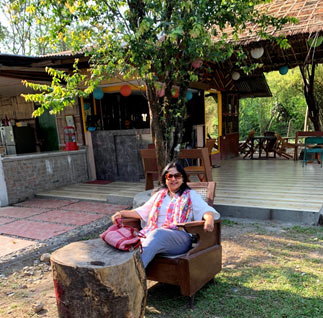 I had made prior bookings at the Abor Country River Camp for our stay in Passighat and on the way I called them up to inform that we will be reaching there at around 7 o’ clock in the evening. But I was taken aback when they said that there was no room available, despite knowing that my booking was confirmed. I later came to know that it is common in this region that when some political leader from their state arrives, they invariably take over all the rooms. And all previous bookings will be refused. At the time of making the bookings online back in Delhi, I had checked out another place named Donyi Hango Camp resort, so I called them and to my relief she said yes we can give you a room with one extra bed. It was a big neat and clean room with a big bathroom. (Tariff for one room – Rs3000 + Rs600 for an extra bed, including breakfast). We had dinner and slept and decided not to stay there another night as there was not much to see except the beautiful Siang river bank. The Siang River originates from China enters India from upper Siang district of Arunachal and in Assam it is known as Brahmaputra.
I had made prior bookings at the Abor Country River Camp for our stay in Passighat and on the way I called them up to inform that we will be reaching there at around 7 o’ clock in the evening. But I was taken aback when they said that there was no room available, despite knowing that my booking was confirmed. I later came to know that it is common in this region that when some political leader from their state arrives, they invariably take over all the rooms. And all previous bookings will be refused. At the time of making the bookings online back in Delhi, I had checked out another place named Donyi Hango Camp resort, so I called them and to my relief she said yes we can give you a room with one extra bed. It was a big neat and clean room with a big bathroom. (Tariff for one room – Rs3000 + Rs600 for an extra bed, including breakfast). We had dinner and slept and decided not to stay there another night as there was not much to see except the beautiful Siang river bank. The Siang River originates from China enters India from upper Siang district of Arunachal and in Assam it is known as Brahmaputra.
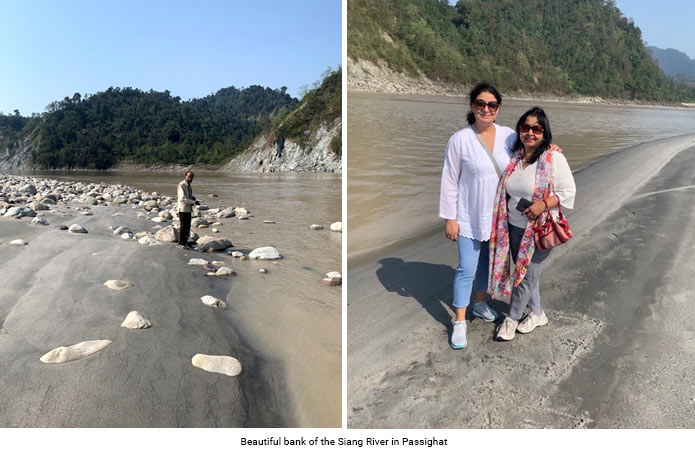
On 6th April, 2021 early morning after breakfast, we packed our things and started for Along after visitng the 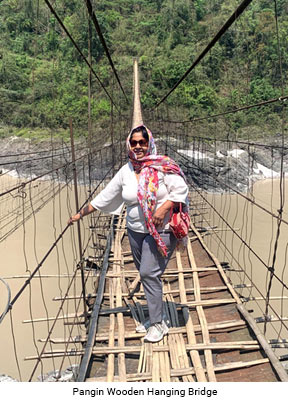 beautiful Siang river bank. My father was so overwhelmed by the serene beauty of the place and he walked around taking pictures. From here on, we just removed our masks and breathed the fresh air of hills and trees.
beautiful Siang river bank. My father was so overwhelmed by the serene beauty of the place and he walked around taking pictures. From here on, we just removed our masks and breathed the fresh air of hills and trees.
From Passighat to Along is about 106 kms but as the road was not so good at many places it took us nearly six to seven hours to reach. On the way, around 60 Kms from Passighat, is the Pangin wooden hanging bridge made of cane and bamboo connecting the two hills. Here we saw clearly the blue water of Siyom River meet the green water of River Siang. Siyom River is a right tributary of the Siang or Brahmaputra.
We made sandwiches and had it at lunch time en route, when we were forced to make a stop for an hour as the road repair work was being carried out.
AALO OR ALONG
(Along is the old name of the town, it is now called Aalo.)
We arrived at our beautiful Reyi’s Homestay in Along at around 4pm. It was a lovely wooden house with beautiful landscaping. (Tariff per day was Rs3000 + Rs600 for one extra bed including breakfast. Homemade dinner charges per person were at veg-Rs300 and non-veg Rs400). There were two big fishery ponds and an orange orchard on the slope. The rooms were very comfortable and big with a balcony. Our host Mr Liduk was a very welcoming and affectionate person. He was happy to know that my father even at the age of Ninety wanted to visit distant places such as this. We had tea and roamed around. My father went for a walk and was so happy, not tired at all even after a six hour drive on hilly roads.
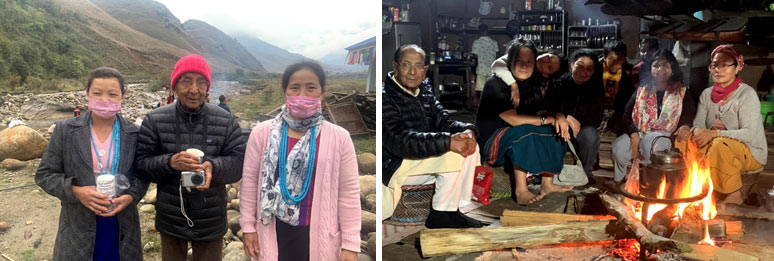
That day happened to be the start of the Mopin festival, which is an important agricultural festival celebrated by the Galo tribe living in East Siang and West Siang. The festival is celebrated every year from 5th to 8th 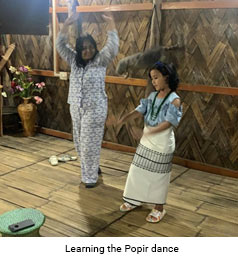 April. The women performed their local traditional dance called Popir at the grounds of their temple for Sun and Moon named Donyi-Polo. (The Galo Tribe worships only Sun (Donyi)and Moon (Polo)). Their festivals and marriage celebrations start with the sacrifice of a bovine species Mithun, which is only found in north-eastern hill region of India and the adjacent areas of China, Myanmar, Bhutan and Bangladesh.
April. The women performed their local traditional dance called Popir at the grounds of their temple for Sun and Moon named Donyi-Polo. (The Galo Tribe worships only Sun (Donyi)and Moon (Polo)). Their festivals and marriage celebrations start with the sacrifice of a bovine species Mithun, which is only found in north-eastern hill region of India and the adjacent areas of China, Myanmar, Bhutan and Bangladesh.
Next day Mr Liduk took us to visit their temple, and told us in detail about the Mopin festival celebrations which involve the whole community. We were invited by a family who were celebrating the festival to their house and got an insight about their rituals, such as applying rice flour on the faces of every guest The lady of the house welcomed us with the serving of Apong a homemade rice wine and a bowl of Aamin, a hot rice, bamboo shoot and meat dish. Both of these were delicious. The priest blessed the lady of the house by giving grains of rice. All the men and women were dressed in their beautiful white with black dresses and colorful expensive beads ornaments . They all dance together and a variety of food was served to everyone. I found the people here so unpretentious and affectionate .
Here the Sun set at around 5.30 pm and the Sunrise were at 4.30 am. There was a severe electricity shortage and everyone relied on the generators in the evening. On 8th April we had an early breakfast and hit the road at 7.30 am for Menchuka, as it was a long and steep uphill drive, additionally that bad stretch of road which was under construction .
MENCHUKA
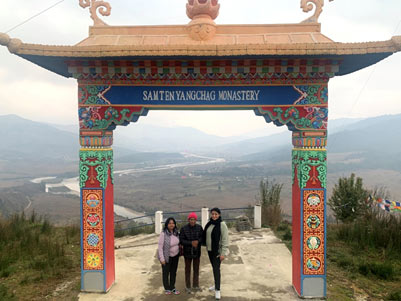 Menchuka comes in Shi Yomi district situated 6000 feet above sea level and 187 kms from Along. The Tibet border is just 29 kms to the north, which separates Indian and Chinese territories. As we drove up we were dazzled by the incredibly beautiful, scenic, untouched and unexplored Menchuka valley. One can see flowing through the valley the big Siang river, which originates from the glacial springs of the Mansarover lake near Mount Kailash in Tibet. Visible in the distance were horses grazing in the fields, the many hanging bamboo bridges. After seven hours long drive when we reached our destination at 4.30 pm it was drizzling and suddenly it became very cold. Worse still was getting to know that there would be no electricity for three days, which apparently was a usual affair here. We were worried about Papa coping with this cold, but the lady of the Gayboo’s Homestay was very helpful. (The tariffs for the nice tent house with attached bathrooms, located a little away from their house were at Rs 3500 + Rs 600 per day including breakfast. Dinner and lunch extra charge.) She gave us plenty of comforters and a hot water bottle for Papa. She started the generator but heaters were unable to work on it. When we finally got a little comfortable with hot tea and layers of warm clothes, we had an early dinner and went to sleep. Food here was bland and more like Tibetan cuisine. In the morning we had Thukpa and fried rice. All of us would sit in their dining hall, which had a bon fire lit up in the middle, and it would keep Papa warm. Here we met a group of four travelers from Gujrat who shared their garlic chutney and Bhakra which was a treat after all that bland food. It was good fun sitting together, eating and chatting. The lady of Gayboo’s Homestay took good care of my father. Next day she introduced us to her father who was 104 years old and in good health.
Menchuka comes in Shi Yomi district situated 6000 feet above sea level and 187 kms from Along. The Tibet border is just 29 kms to the north, which separates Indian and Chinese territories. As we drove up we were dazzled by the incredibly beautiful, scenic, untouched and unexplored Menchuka valley. One can see flowing through the valley the big Siang river, which originates from the glacial springs of the Mansarover lake near Mount Kailash in Tibet. Visible in the distance were horses grazing in the fields, the many hanging bamboo bridges. After seven hours long drive when we reached our destination at 4.30 pm it was drizzling and suddenly it became very cold. Worse still was getting to know that there would be no electricity for three days, which apparently was a usual affair here. We were worried about Papa coping with this cold, but the lady of the Gayboo’s Homestay was very helpful. (The tariffs for the nice tent house with attached bathrooms, located a little away from their house were at Rs 3500 + Rs 600 per day including breakfast. Dinner and lunch extra charge.) She gave us plenty of comforters and a hot water bottle for Papa. She started the generator but heaters were unable to work on it. When we finally got a little comfortable with hot tea and layers of warm clothes, we had an early dinner and went to sleep. Food here was bland and more like Tibetan cuisine. In the morning we had Thukpa and fried rice. All of us would sit in their dining hall, which had a bon fire lit up in the middle, and it would keep Papa warm. Here we met a group of four travelers from Gujrat who shared their garlic chutney and Bhakra which was a treat after all that bland food. It was good fun sitting together, eating and chatting. The lady of Gayboo’s Homestay took good care of my father. Next day she introduced us to her father who was 104 years old and in good health.
Next day luckily it was a clear day. We went to see the old Monastery Samten Yongcha Gompa located on a hill top. It was built in 14th Century. Located 14 kms from the city, it is older than the Tawang Monastery. We got a breathtaking panoramic view from there of the valley with Siang river flowing. This place had remained inaccessible by road until the Dalai Lama visited there in 2003. The Memba, Adi and Booker tribes, said to have migrated from Tibet long ago, reside here. The Membas are Buddhist and the Adi practice nature worship of the Donyi- Polo.

Guru Nanak Dev ji is said to have meditated in a cave at Menchuka, in Taposthan, which has a lovely Gurudwara near the river made by Indian army personnel. At all times there are two or three army people posted at the Gurudwara and they ensure no one goes without eating the Langar of delicious simple food. It’s amazing how they live there in winters in minus temperature away from their families.Near the last permanent camp of the Indian army was a View Point, overlooking a hill with a natural formation of a face resembling lord Hanuman. Yarlung is the last border village 30 kms from here. We also went to see the new monastery, which is in the city on a hill top, from where we could see the whole Menchuka valley and the houses with their colourful rooftops.
Dorjeeling is a picturesque village 12 kms from Menchuka with wooden houses, farms and blue water streams. It’s just another world here, where one could breathe fresh air, sans pollution, sans noise and such a treat for the eyes to see the surroundings. No phone and Internet connectivity there.
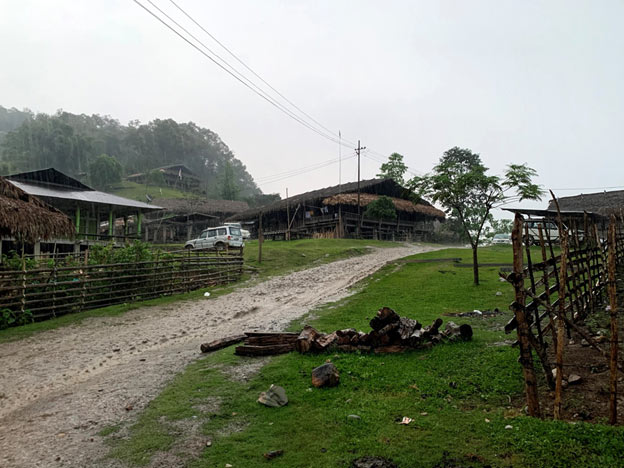
Back to AALO / ALONG
On 10th April, we started back and decided to stop over in Along instead of Passighat, as we loved the place and Reyi’s Homestay. Mr Liduk was happy to have papa and us back again. He took us to his village to show the houses and lifestyle there. They grow their own vegetables in the backyard. There were huge wooden houses on stilts with the whole family living together. They served us rice wine and some snacks .Every house has a big central room with a big fireplace where they roast there meat and sit together. With big buckwheat and rice farms, here the whole village lives like a family and celebrate all their festivals together. Some cultural changes have taken place over time, as they shared. Earlier the custom was of arranged marriages in which grooms family gave gifts to the bride’s family. But now it is the trend for love marriages, as the children are going to study in the big cities and make up their own mind. Next morning after breakfast we started early from Along, as it was again a long drive of eight hours to Namsai.
NAMSAI – GOLDEN PAGODAS
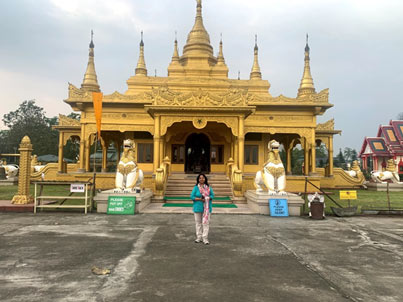 After Passighat we crossed Roing, a scenic place on the foothills and reached Namsai, where we had lunch and rested at our beautiful stay at Golden Pagodas. This is the biggest of the monasteries in north east India. It is also known as Kongmu Khan a Burmese style Buddhist temple. It looks beautiful in the night time. Never knew that this place was so ancient and culturally rich, and its religiosity was significantly of importance in ancient India. Golden Pagoda has beautiful cottages and big rooms with a big bathroom, however when we asked for the third bed they only provided a mattress. We refused to sleep on the floor, but there was no one to talk to. Finally all three of us managed on the double bed. (Tariff was Rs 3372 including taxes + Rs 632 for the extra mattress, including breakfast). The restaurant at Golden Pagoda had good food. In the Namsai market we found a
After Passighat we crossed Roing, a scenic place on the foothills and reached Namsai, where we had lunch and rested at our beautiful stay at Golden Pagodas. This is the biggest of the monasteries in north east India. It is also known as Kongmu Khan a Burmese style Buddhist temple. It looks beautiful in the night time. Never knew that this place was so ancient and culturally rich, and its religiosity was significantly of importance in ancient India. Golden Pagoda has beautiful cottages and big rooms with a big bathroom, however when we asked for the third bed they only provided a mattress. We refused to sleep on the floor, but there was no one to talk to. Finally all three of us managed on the double bed. (Tariff was Rs 3372 including taxes + Rs 632 for the extra mattress, including breakfast). The restaurant at Golden Pagoda had good food. In the Namsai market we found a 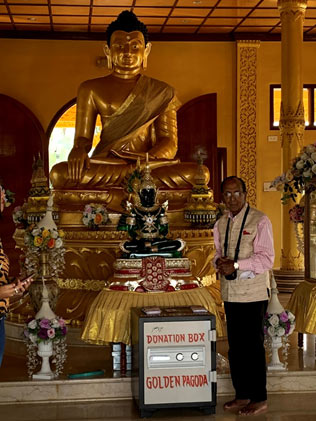 very good Agrawal Sweets restaurant which served all the varieties of Chat etc. We spoke to the owner and found he was originally from Jaipur but had been living here since the last twenty years. Everything we ate was so tasty there.
very good Agrawal Sweets restaurant which served all the varieties of Chat etc. We spoke to the owner and found he was originally from Jaipur but had been living here since the last twenty years. Everything we ate was so tasty there.
Papa added Tezu to his list. When I read about I did not find anything of importance here in Tezu. It was just a small town where there was not a single decent place to stay. But I soon discovered the reason why people flock to this place. Piligrims come here to visit the legendry Parshuram Kund, Tamreshwari temple, Shivalinga. This region is mentioned in Kalika Puran and Vishnu Puran etc.
Next morning we visited the Golden Pagodas and went to the Parshuram Kund which was 64 kms from there. It is a place of huge religious significance, a big festival is held every year on the Shivratri day with thousands of pilgrims arriving here. This was the last place on our list.
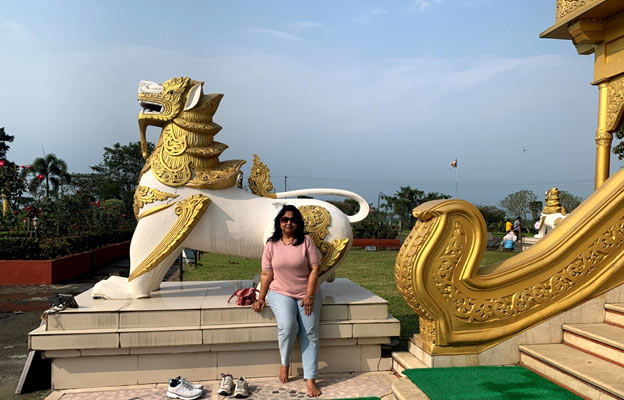
Back to DIBRUGARH, Assam
We reached Dibrugarh at 4 pm and shopped for Assam tea before heading to our guesthouse to rest. Neena and I enjoyed thoroughly taking care of Papa and every evening playing cards with him. Papa remembered that when I was a kid, he would hold my hand, and now it is we who are holding his hand. Thankfully all went well. Most importantly, seeing my father so happy made this trip my most memorable one. From Dibrugarh we took our return flight back to Delhi.
